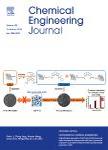版权所有:内蒙古大学图书馆 技术提供:维普资讯• 智图
内蒙古自治区呼和浩特市赛罕区大学西街235号 邮编: 010021

作者机构:Soochow Univ Affiliated Hosp 1 Coll Pharmaceut Sci Suzhou Med Coll Suzhou 215123 Peoples R China Soochow Univ Affiliated Hosp 1 Dept Radiol Suzhou 215006 Peoples R China Zhengzhou Univ Henan Eye Hosp Henan Prov Peoples Hosp Peoples Hosp Zhengzhou 450003 Peoples R China Henan Acad Innovat Med Sci Henan Eye Inst Zhengzhou 450003 Peoples R China
出 版 物:《CHEMICAL ENGINEERING JOURNAL》 (Chem. Eng. J.)
年 卷 期:2025年第504卷
核心收录:
学科分类:0830[工学-环境科学与工程(可授工学、理学、农学学位)] 0817[工学-化学工程与技术] 08[工学]
基 金:Priority Academic Program Development (PAPD) of Jiangsu Higher Education Institutions [2022ZB598] Suzhou International Joint Laboratory for Diagnosis and Treatment of Brain Diseases
主 题:Tumor microenvironment MRI NIR-II Photothermal Conjugated polymer
摘 要:Enormous developments have been achieved in the design of organic theranostics agents simultaneously with diagnostic and therapeutic performances, especially in the second near-infrared (NIR-II, 1000-1700 nm) window. One major challenge for the further progress of organic theranostics agents is the rarity of efficient materials simultaneously integrated with optical and magnetic performances, especially with tumor-responsive performance. Herein, a magnetic resonance imaging (MRI)-sensitive, NIR-II-excitable conjugated polymer material is developed as a multifunctional nanoplatform for efficient tumor microenvironment (TME)-activated multimodal cancer theranostics. With D-A molecular engineering and ferrocene anchoring, the absorption capability of ferrocene-typed conjugated polymers (FCPs) can be rationally regulated to achieve NIR-II absorption. The water-dispersive FCP-3 NPs demonstrate superior NIR-II-excitable photothermal performance (PCE = 54 %) and T2-weighted MRI responses toward tumor endogenous H2O2. Upon NIR-II irradiation, FCP-3 NPs can efficiently generate reactive oxygen species (ROS) through NIR-II photothermal-augmented Fenton reaction in the TME. Both in vitro and in vivo experiments confirm that the FCP-3 NPs have high-performance combination therapy of NIR-II photothermal therapy and augmented chemodynamic therapy with TME-sensitive magnetic resonance and photoacoustic dual-modal imaging, which realizes 100 % tumor elimination with high safety. This work offers a major step toward designing tumor microenvironment-activated polymeric materials for smart multimodal cancer theranostics.